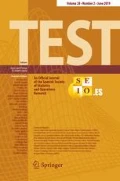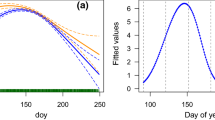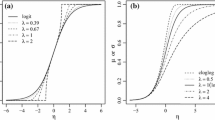Abstract
In this work, we introduce a regression model for double-bounded variables in the interval (0, 1) following a Kumaraswamy distribution. The model resembles a generalized linear model, in which the response’s median is modeled by a regression structure through the asymmetric Aranda-Ordaz parametric link function. We consider the maximum likelihood approach to estimate the regression and the link function parameters altogether. We study large sample properties of the proposed maximum likelihood approach, presenting closed-form expressions for the score vector as well as the observed and Fisher information matrices. We briefly present and discuss some diagnostic tools. We provide numeric evaluation of the finite sample inferences to show the performance of the estimators. Finally, to exemplify the usefulness of the methodology, we present and explore an empirical application.


Similar content being viewed by others
Notes
Lemma 3, in particular, is presented and proved in the supplementary material that accompanies the paper.
References
Akaike H (1974) A new look at the statistical model identification. IEEE Trans Autom Control 19(6):716–723
Aranda-Ordaz FJ (1981) On two families of transformations to additivity for binary response data. Biometrika 68(2):357–363
Arundel AV, Sterling EM, Biggin JH, Sterling TD (1986) Indirect health effects of relative humidity in indoor environments. Environ Health Perspect 65:351–361
Bayer FM, Bayer DM, Pumi G (2017) Kumaraswamy autoregressive moving average models for double bounded environmental data. J Hydrol 555:385–396
Benjamin M, Rigby R, Stasinopoulos D (1998) Fitting non-Gaussian time series models. In: COMPSTAT proceedings in computational statistics Heidelburg: Physica-Verlag, pp 191–196
Cai Z, Xiao Z (2012) Semiparametric quantile regression estimation in dynamic models with partially varying coefficients. J Econom 167(2):413–425
Canterle DR, Bayer FM (2019) Variable dispersion beta regressions with parametric link functions. Stat Pap 60(5):1541–1567
Czado C (1997) On selecting parametric link transformation families in generalized linear models. J Stat Plan Inference 61(1):125–140
Czado C, Munk A (2000) Noncanonical links in generalized linear models: when is the effort justified? J Stat Plan Inference 87:317–345
Dehbi H-M, Cortina-Borja M, Geraci M (2016) Aranda-Ordaz quantile regression for student performance assessment. J Appl Stat 43(1):58–71
Dunn PK, Smyth GK (1996) Randomized quantile residuals. J Comput Graph Stat 5(3):236–244
Fahrmeir L (1987) Asymptotic testing theory for generalized linear models. Statistics 18(1):65–76
Fahrmeir L, Kaufmann H (1985) Consistency and asymptotic normality of the maximum likelihood estimator in generalized linear models. Ann Stat 1(13):342–368
Fletcher S, Ponnambalam K (1996) Estimation of reservoir yield and storage distribution using moments analysis. J Hydrol 182(1–4):259–275
Fokianos K, Kedem B (1998) Prediction and classification of non-stationary categorical time series. J Multivar Anal 67:277–296
Gomes GSDS, Ludermir TB (2013) Optimization of the weights and asymmetric activation function family of neural network for time series forecasting. Expert Syst Appl 40(16):6438–6446
Gradshteyn IS, Ryzhik IM (2007) Table of integrals, series, and products, 7th edn. Academic Press, Cambridge
Gunawardhana LN, Al-Rawas GA, Kazama S (2017) An alternative method for predicting relative humidity for climate change studies. Meteorol Appl 24(4):551–559
Gupta AK, Nadarajah S (2004) Handbook of beta distribution and its applications. CRC Press, Boca Raton
Jones M (2009) Kumaraswamy distribution: a beta-type distribution with some tractability advantages. Stat Methodol 6(1):70–81
Koenker R (2005) Quantile regression. Econometric society monograph series, Cambridge University Press, Cambridge
Kumaraswamy P (1980) A generalized probability density function for double-bounded random processes. J Hydrol 46(1):79–88
Mathieu J (1981) Tests of \(\chi ^2\) in the generalized linear model. Ser Stat 12(4):509–527
McCullough P, Nelder JA (1989) Generalized linear models. Chapman & Hall, London
Mitnik PA (2013) New properties of the Kumaraswamy distribution. Commun Stat Theory Methods 42(5):741–755
Mitnik PA, Baek S (2013) The Kumaraswamy distribution: median-dispersion re-parameterizations for regression modeling and simulation-based estimation. Stat Pap 54(1):177–192
Muggeo V, Ferrara G (2008) Fitting generalized linear models with unspecified link function: a p-spline approach. Comput Stat Data Anal 52:2
Nadarajah S (2008) On the distribution of Kumaraswamy. J Hydrol 348(3):568–569
Nagelkerke NJ (1991) A note on a general definition of the coefficient of determination. Biometrika 78(3):691–692
Papker L, Wooldridge J (1996) Econometric methods for fractional response variables with an application to 401 (K) plan participation rates. J Appl Econom 11:619–632
Pereira GH (2017) On quantile residuals in beta regression. Commun Stat Simul Comput 46:1–15
Pereira TL, Cribari-Neto F (2014) Detecting model misspecification in inflated beta regressions. Commun Stat Simul Comput 43(3):631–656
Press WH, Teukolsky SA, Vetterling WT, Flannery BP (1988) Numerical recipes in C, vol 1. Cambridge University Press, Cambridge, p 3
Ramsey JB (1969) Tests for specification errors in classical linear least-squares regression analysis. J R Stat Soc Ser B 31:350–371
Sánchez S, Ancheyta J, McCaffrey WC (2007) Comparison of probability distribution functions for fitting distillation curves of petroleum. Energy Fuels 21(5):2955–2963
Schwarz G et al (1978) Estimating the dimension of a model. Ann Stat 6(2):461–464
Sundar V, Subbiah K (1989) Application of double bounded probability density function for analysis of ocean waves. Ocean Eng 16(2):193–200
Team RC (2018) R: a language and environment for statistical computing. R Foundation for Statistical Computing, Vienna
Tutz G, Petry S (2012) Nonparametric estimation of the link function including variable selection. Stat Comput 22(2):545–561
Acknowledgements
We would like to thank two anonymous referees for valuable comments and suggestions that helped to improve the quality of the paper.
Author information
Authors and Affiliations
Corresponding author
Additional information
Publisher's Note
Springer Nature remains neutral with regard to jurisdictional claims in published maps and institutional affiliations.
We gratefully acknowledge partial financial support from Capes and CNPq, Brazil.
Electronic supplementary material
Below is the link to the electronic supplementary material.
Rights and permissions
About this article
Cite this article
Pumi, G., Rauber, C. & Bayer, F.M. Kumaraswamy regression model with Aranda-Ordaz link function. TEST 29, 1051–1071 (2020). https://doi.org/10.1007/s11749-020-00700-8
Received:
Accepted:
Published:
Issue Date:
DOI: https://doi.org/10.1007/s11749-020-00700-8




